ACT II, PART III
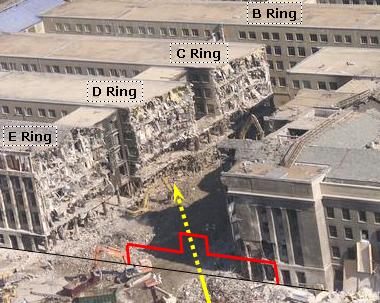
The remarkable photo to the left, taken after a considerable amount of demolition work had been done, reveals an actual cross-section of the three connected rings of the Pentagon. Notice the number of columns and walls that would have to be cleanly penetrated to blast completely through this massive concrete, brick and limestone structure. And consider that to pass through at a 45 degree angle, a projectile would have to plow through nearly 100 additional feet of concrete obstacles, the equivalent of approximately 1½ more rings.
The distance from the alleged point of penetration to the alleged exit wound was just over 300 feet. For you sports-minded readers, that’s an entire football field. Imagine that across each goal line of that football field is a 24″ thick, steel-reinforced masonry wall. And down each sideline as well. Imagine also that every five yards or so, across the entire field, in both directions, are 24″ square, reinforced concrete columns. Now imagine that there are several concrete slabs spanning between that network of columns, each five-and-a-half inches thick, spaced about fourteen feet apart. Now add some concrete ramps here and there to connect the floors. What we have then, so far, is something the size of a football field that closely resembles a walled, multi-story parking structure. Now add to that, every four or five yards, interior walls, some masonry and some of lightweight construction. Don’t forget to add them in both directions, across the entire width and length of the field. If you’d like, you can also add file cabinets, desks, and various other bulky office furnishings, but that’s really optional. The important thing here is to consider how likely it would be that a 757 flown into the fortress wall at one end of the field would blast its way through a hole in the fortress wall at the other end of the field. I’m guessing not very likely at all.
* * * * * * * * * *
So what really did happen at the Pentagon on September 11, 2001? When I began writing this piece – just a couple short weeks ago, though it seems much longer – I was leaning towards a scenario that involved a missile fired into the point of entry (to create the initial penetration, the facade damage, and the fireball), combined with explosives placed within the building, possibly quite hastily, to create all of the following: the collapse of “E” ring (necessary to hide the fact that no plane actually entered the building); much of the destruction along the ‘path of travel’; and the alleged ‘exit’ hole.
In other words, my theory was that both a missile (possibly fired by a passing jet, assuming that some of the witness reports, and the air traffic controller reports, were accurate) and supplemental explosives were used to simulate, albeit rather poorly, the crash of a passenger plane. That would explain, among other things, why “secondary explosions and plumes of smoke” were reported by witnesses to Washington Post reporters.
But is that what really happened? The reality is that we will likely never know what really happened at the Pentagon that morning. As at the site of the World Trade Center towers, all evidence was quickly bulldozed away. And even if it hadn’t been, we would not likely have learned what secrets lay buried in the rubble. We are talking here, after all, about the Pentagon, which isn’t the kind of place that a truly independent investigator could have wandered into to take a look around.
We will never know which aspects, if any, of the alleged CCTV images are legitimate. Nevertheless, a number of investigators on both sides of the debate have spent countless hours attempting to prop up the images as ‘proof’ either that a 757 did hit the Pentagon, or that a 757 did not hit the Pentagon, when neither conclusion can ever be drawn from grainy, low-resolution images that have clearly been doctored.
We will never have any way of verifying the accuracy of the purported damage report. Was there really extensive structural damage extending well beyond “E” ring? The report says there was, but numerous aerial photos of the buildings reveal little indication of such damage lying within. Even the two-story buildings, amazingly enough, were able to completely conceal the extensive damage.
We really don’t know, with any certainty, how many of the ‘witness’ reports are fraudulent accounts planted in the media. Many of the witnesses were themselves members of the Washington press corps, whose primary function is parroting government lies. We also don’t know how many of the reports are more a reflection of what the witnesses wanted to see than what they actually did see. Any major event, after all, will draw out ‘witnesses’ driven by a desire to be a part of history in the making.
There have been, to date, around 150 published witness reports, with roughly a third of those witnesses claiming to have seen something impacting the Pentagon. The majority of the accounts do not strictly conform to the official story. Indeed, perhaps what is most surprising about the witness accounts of the attack on the Pentagon – considering the magnitude of the event, and the fact that, by 9:38 AM on the morning of September 11, 2001, more than a few people in Washington were nervously scanning the skies for signs of errant aircraft – is that there aren’t a lot more of them.
Some investigators seem to have spent countless hours constructing elaborate theories around multiple witness reports that not only contradict each other, but contradict the photographic evidence as well. The effort seems rather pointless, given that anyone can cherry-pick from the available ‘witness’ reports to validate any number of theories — just as I did at the top of this post.
It has occurred to me, as I’ve been mulling over the evidence, that maybe that is the ultimate goal — to deliberately render the evidence so ambiguous and indecipherable that it becomes impossible to construct a logical and coherent theory that accounts for all the known ‘evidence.’ If no alternative scenario can be constructed that won’t be immediately attacked for ignoring some aspect of the ‘evidence,’ then the official story, by default, becomes the truth.
It was almost certainly realized, very early on, that the Flight 77 fable wasn’t going to stand up to the slightest bit of scrutiny. The official story, such as it is, cannot really be defended directly, so a very deliberate effort has been made to thoroughly muddy the waters and render the available evidence hopelessly ambiguous and inconclusive.
Nevertheless, even through the fog it is perfectly obvious that the one conclusion that can be drawn is that it was not a Boeing 757 passenger jet that caused the damage to the Pentagon on the morning of September 11, 2001. What evidence, after all, supports the official story? A smattering of witness reports, to be sure, but those are contradicted by other witness reports and by virtually all of the photographic evidence. In addition to the witness reports, there is the extremely dubious, and unverifiable, forensic identification of the passengers. Then there is the official damage report, which is supposed to support the official story, but in reality reports damage that couldn’t possibly have been inflicted by a passenger plane. The only other aspects of the evidence that support the official story are the notorious clipped-off light poles, and the widely circulated photos that purportedly depict aircraft debris in and outside the Pentagon.
* * * * * * * * * *
The Flight 77 story has been vocally defended by more than a few 911 ‘skeptics,’ some of whom have shown a curious willingness to toss credibility and consistency out the door when necessary. Michael Rivero, of WhatReallyHappened.Com, provides a good case study.
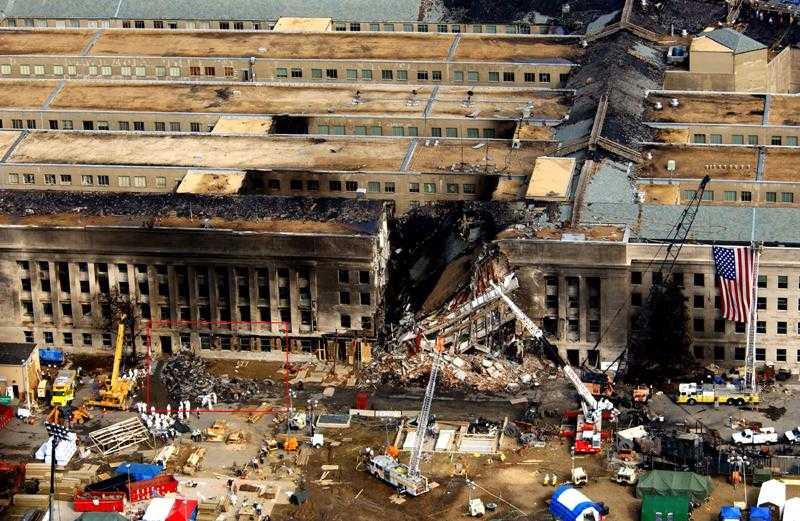
To explain the lack of aircraft wreckage outside the Pentagon, Rivero presents a single post-collapse photo (left) and claims that the aircraft “slid INTO the building, into the first floor space, starting a fire in the first floor, whereupon the upper floors later collapsed down onto the remains of the aircraft. Most of the aircraft wreckage is therefore under the collapsed roof section in the photo.”
A few paragraphs later, Rivero reveals that “aircraft are relatively fragile objects due to weight considerations.” I was shocked by that revelation, having been fooled into believing that aircraft had to be pretty sturdy to withstand years of exposure to the stresses of things like sudden and extreme weather changes, heavy turbulence, and icing. But I guess not. According to Rivero, “jet aircraft … are, if you think about it, mostly filled with air, like an aluminum balloon.”
I’m not entirely sure that Rivero understands the difference between a blimp and an airplane, but I hate to stop him when he’s on a roll, so let’s listen and learn as he compares a commercial aircraft to a glass Christmas tree ornament: “Take a glass Christmas ornament and hurl it against a brick wall. Do you get a round opening in the brick wall the size of the ornament? No, of course not. Neither will an aluminum plane leave a clean outline of itself crashing into concrete. In the case of the plane, there are subassemblies which are heavy and solid, such as the engines, the frames supporting the landing gear, cockpit avionics, the potable water tanks, APU, etc. On impact, these would break loose from the aircraft and continuing forward, produce smaller holes.”
Uhmm … but what happened to the plane sliding into the building? Rivero has inadvertently provided a wonderful example here of the impossibility of defending the official story while maintaining even a hint of credibility. To explain the lack of aircraft wreckage outside the Pentagon, he claims that the plane slid into the building and was then buried under rubble. But then, just a few paragraphs later, while struggling to explain the lack of an entry wound, he makes the completely contradictory claim that the plane essentially blew apart on impact.
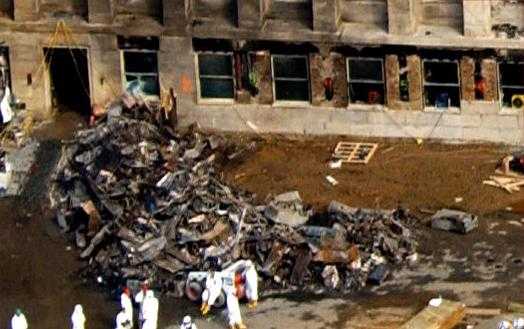
In the same post, Rivero makes a bold claim about the pile of indeterminate debris identified by the red rectangle in the photo above. “The Pentagon is a building mostly made of concrete and wood,” Rivero writes, “Yet here is a pile of crumpled aluminum debris, and clearly seen mixed in with it are pieces of luggage. Since the Pentagon itself does not travel, we can conclude that the luggage (and the aluminum shards mixed with them) are part of the remains of the passenger jet which hit the Pentagon.”
I have to concede that I apparently do not have the visual acuity of a Michael Rivero, so it is not entirely clear to me how he could have possibly determined that what we are looking at is “aluminum debris,” let alone the remains of a passenger airplane. I’m also a little unclear on which pieces of debris are luggage and which are aircraft parts. It’s hard to tell when everything is carelessly jumbled together like that, and shoved around by that Bobcat visible in the foreground. But that is, of course, exactly the kind of respect that we would expect would be shown for the personal effects of the Pentagon victims. Hell, for all we know, they might have even tossed some bodies in the pile. In fact, it would be fair to say that the human remains in the pile can be identified with the same level of certainty as the pieces of luggage and aircraft debris in the pile.
One conclusion that can be safely drawn from this photo is that the materials in the pile, whatever they may be, were removed from the building through the open entry door that the debris is piled just outside of. And that door quite obviously does not lead into the portion of the Pentagon that was allegedly hit by the plane. In addition to that, the plane, according to Rivero, is still lying buried beneath the collapsed portion of the building. How, one wonders, was all this alleged wreckage recovered before excavation had even begun on the collapsed portion of the Pentagon?
Joe Vialls displays the very same photo and makes more outlandish claims about the pile of debris: “Which bits of the pile are which bits of American Airlines Flight 77 you had best decide for yourself, because there are lots of bits to choose from … Though most of the Boeing 757 was still in the Pentagon basement [or even below it] on that date, only three days after the crash, there is already enough scrap metal on the pile to construct a pair of fighter aircraft from scratch. And because this aircraft wreckage utterly destroys the French conspiracy, they failed to show it to you. Worse than that. The French deliberately edited it out completely, so you would be unable to reach your own conclusions.”
Those goddamn French! Unlike those “wine-swilling Parisians,” as Vialls refers to them, I have no problem displaying the photo. In fact, unlike Vialls and Rivero (and numerous others), I have tried to present here a representative sampling of all the photographic evidence, even some that I consider to be fraudulent and/or too grainy and ambiguous to be of any value. That, you see, is what enables people to reach their own conclusions.
You may find yourself wondering, by the way, how in the world Flight 77 could have ended up in the Pentagon’s basement. The answer, according to Vialls, is that the plane actually dive-bombed into the Pentagon, barreling straight down into the bowels of the building. And it did so, amazingly enough, without leaving any penetrations in the roof of the complex. Vialls has boldly opted to blaze his own trail on this one, disregarding pretty much all of the available evidence. He has also failed to explain how aircraft debris was excavated from the basement without disturbing the mountain of concrete lying on top of it.
Moving on, I am required by the Fairness Doctrine to show you some additional photos that allegedly depict aircraft debris. However, it is my understanding that the doctrine places no restrictions on my right to thoroughly mock and ridicule this alleged evidence. We will begin with the alleged debris that was photographed either in “C” ring or in the walkway between “C” ring and “B” ring, and then we will move on to the notorious piece of debris allegedly left on the Pentagon lawn. Like the alleged aircraft debris presented by Rivero and Vialls, none of this alleged debris has ever been officially acknowledged — which seems rather odd, since you would assume that the Washington gang would be eager to embrace any evidence that supposedly lends credence to the official story.
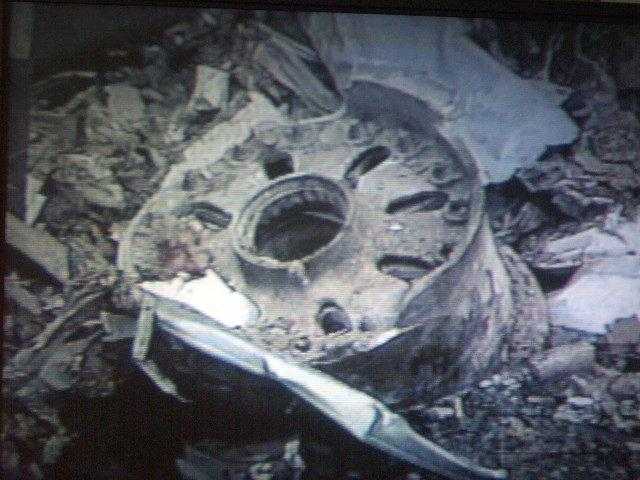
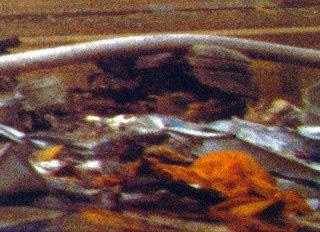
First up we have this wheel, reportedly photographed outside the infamous ‘exit’ hole in “C” ring. It is claimed to be part of the landing gear of a Boeing 757. Also photographed in the walkway between “B” and “C” rings is a grainy black object alleged to be the tire that was once mounted to that wheel. Of course, it is impossible to ascertain whether the object to the right is a tire at all, let alone a tire from the landing gear of a 757, just as it isn’t really possible to verify where the photo to the left was actually taken. If we accept that the items are what they are claimed to be, and that they were photographed outside of “C” ring, and that they weren’t planted there, then we must also accept that not only can lightweight aircraft parts smash their way through literally dozens of concrete and steel barriers, but they can emerge from such an ordeal nearly intact and in readily recognizable form. Who knew that alloy rims and rubber tires were actually tougher than multiple layers of concrete, steel, brick, and limestone?
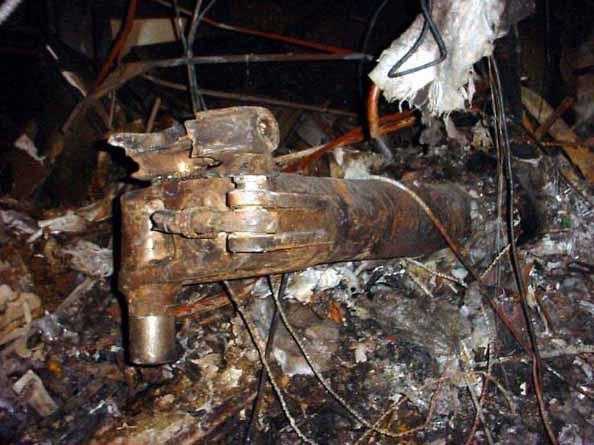
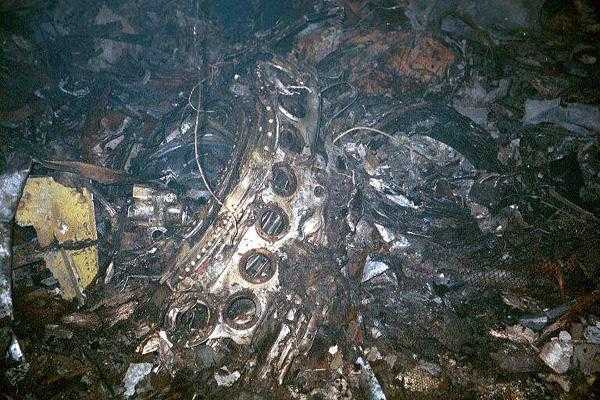
Next up is the photo to the right, which depicts … uhhh, I have to be honest here — I have no clue what it is supposed to be. Some kind of manifold or something. And it was discovered … uhmm, somewhere in the Pentagon, I suppose, but that can’t actually be determined from the photo. Obviously then it must be debris from Flight 77. To the left, jutting out prominently from a pile of indeterminate debris, and obviously better lit and in much sharper focus than other alleged interior shots of alleged aircraft debris, is what is claimed to be yet another component of a Boeing 757’s apparently indestructible landing gear. Whatever.
Similar grainy photos of indeterminate origin can be found on various websites devoted to bolstering the official story through the use of unofficial ‘evidence.’ None of the photos depict any large pieces of actual, identifiable aircraft wreckage. Even if all the of the photos did actually depict debris from a 757, and if all that debris was actually found inside the Pentagon, then a few hundred pounds of Flight 77 has been accounted for. That leaves well over 100 tons unaccounted for — plus all the passengers and crew, since none of the photos, strangely enough, depict any human remains mixed in with the aircraft debris.
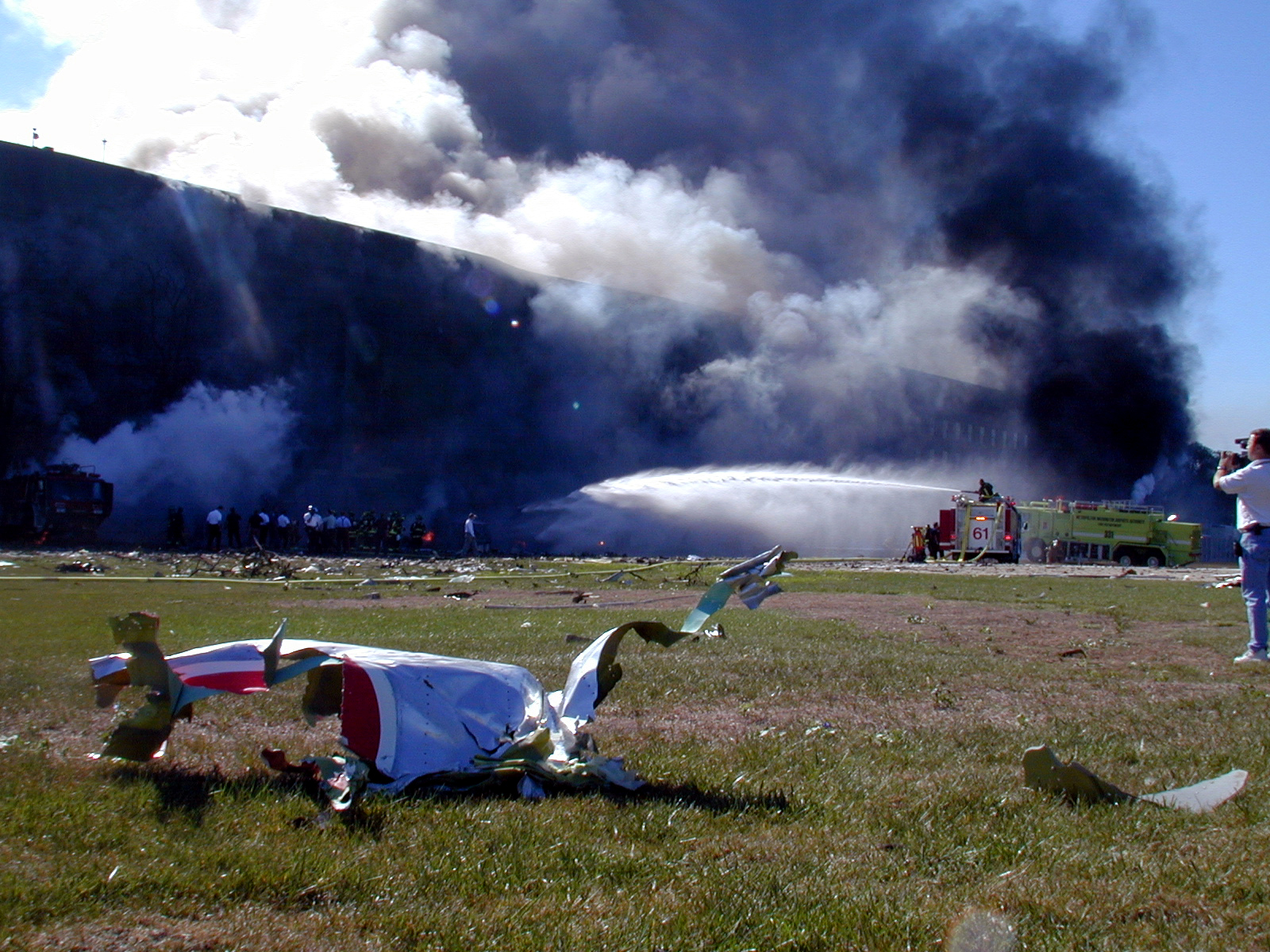

We now turn our attention to these infamous images, which I like to call the “is it an airplane or is it a soda can?” photos. This immaculately preserved piece of debris, lovingly photographed by a writer for Navy Times, but ignored by everyone else on the scene, is purportedly a portion of American Airlines Flight 77. Despite having endured both a 450 mile per hour (the speed varies in various accounts) impact into dense concrete, and the massive fireball that resulted from that impact, this purported aircraft wreckage, sitting all by itself, far from the alleged point of impact, doesn’t appear to be charred in the least. After these photos were taken, the mysterious debris was never seen again, nor ever mentioned in any official accounts of the alleged crash.
That is kind of a shame, when you think about it, because it might have been nice to have a piece of history like that displayed in a museum or something. Perhaps the Smithsonian might have been able to find it a suitable home. Better yet, it could have been mounted on a granite base and planted on the Pentagon lawn, exactly where it sits, as a permanent memorial to the victims of the September 11 attacks.
Some researchers have claimed that it is actually just one of many pieces of aircraft debris visible in these two photos. Behind it, some say, lies a large ‘debris field’ of shredded aircraft parts. It seems far more likely, however, that the debris closer to the building, which the emergency personnel are freely trampling over, is nothing more than shattered pieces of the building’s limestone veneer, a considerable amount of which was blasted away.
All of this photographic evidence of alleged debris appears to have been ‘unofficially,’ but actually quite deliberately, leaked. The goal appears to be to silence critics of the official 9-11 narrative while carefully avoiding officially acknowledging the existence of the alleged debris. The reason for such a strategy is obvious: Washington cannot acknowledge the existence of what are purported to be random bits and pieces of the aircraft without admitting that it cannot account for the other 99.9% of the wreckage.
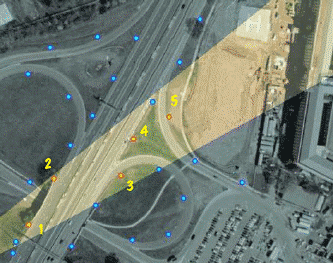
Last on the evidence list is the ever-popular ‘toppled light pole’ evidence. To bring those of you unfamiliar with all the minutiae of the Pentagon attack up to date, the 757 that allegedly hit the Pentagon allegedly clipped off five light poles on its way to doing so. And those light poles, of course, were directly in line with the trajectory of the plane established by the entry and exit wounds in the Pentagon and the reported pattern of internal structural damage. Toss in a pinch of debris and a handful of dubious witness statements, stir the whole thing up real good, and you have an open-and-shut case — to a casual observer unaware of the fact that neither the entry hole nor the exit hole could have possibly been created by the crash of a Boeing 757.
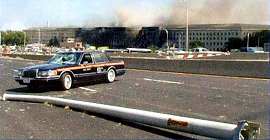
The light pole evidence is considered by some researchers to be a crucial piece of the puzzle, because it allegedly establishes three things: the trajectory of the plane on its approach to the Pentagon; the approximate wingspan of the plane (based on the spacing of the poles); and the plane’s extremely low approach altitude. The toppled light poles, however, are problematic in a number of ways.
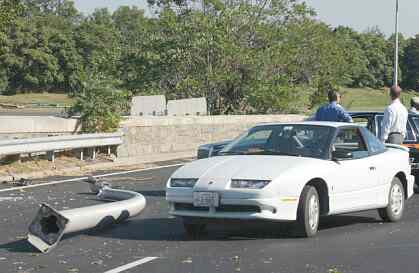
As can be seen in these photos, these were very sturdy poles that appear to have been ripped cleanly away from their foundations without doing substantial damage to the bases of the posts. You would think that if a 100+ ton metal object traveling at hundreds of miles per hour impacted a steel light pole, it might, at the very least, maybe dent the pole, or perhaps bend it a little bit. In other words, you would think that there would be some kind of impact scar visible on the toppled pole. You would also think that there might be signs of extreme stress at base of the pole, where it had presumably been securely bolted to a concrete footing before being violently torn loose. But you would be mistaken in those assumptions.
You might also conclude that if an airplane hit a sturdy steel light pole with enough force to cleanly uproot it, the impact might do some pretty serious damage to the airplane — maybe take off part of a wing, or disable an engine, or rip a hole in the fuselage. But again you would be mistaken, just as you would be mistaken if you were to assume that an enormous, unwieldy passenger plane already flying in an exceedingly dangerous and unlikely manner would almost certainly crash after hitting just one light pole, let alone five in a row. Consider that an airplane with a 125 foot wingspan flying just 20 feet or so off the ground has very little margin for error. Even a relatively minor tilt to one side or the other would result in one of the wing tips hitting the ground, thus precipitating a very messy crash that would have left the area littered with large pieces of aircraft wreckage.
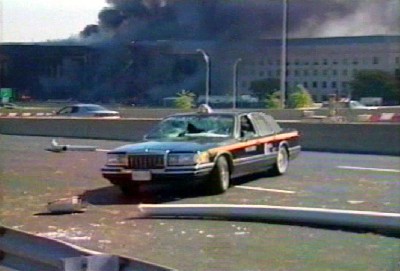
According to the approach path graphic, both wings of the plane clipped light poles, three on the left side and two on the right side. And yet, amazingly enough, the pilot was able to maintain perfect control of his aircraft, completing a perfectly stable, high-speed, ground-level approach that would have been all but impossible even in a 757 that had not suffered any damage to its wings and engines. According to some accounts, the right wing of the plane also impacted a large generator on the approach path.
As is apparent from the height of the light poles, an airplane flying low enough to clip them with its wings would have been all but scraping its engines across the roofs of the cars on the highway. And, sure enough, there is at least one witness report of the plane actually clipping off the antenna of a Jeep Grand Cherokee.
Incredibly enough, some researchers have actually tailored their Pentagon theories to account for this alleged evidence, but I have no idea why. Are these theorists really that naive, or do they just pretend to be? Is it not perfectly obvious that this so-called evidence is patently absurd? How much thrust do you suppose is required to get a fully-loaded, 100+ ton aircraft off the ground and then propel it through the air at 500+ miles per hour? Isn’t an aircraft engine essentially just an immensely powerful fan that is capable of displacing massive quantities of air and expelling it at an extremely high velocity? Is there something I am missing here?
Some time ago, I watched an episode of the television show “Myth Busters” in which one of the myths tested was a story about a car being literally flipped over by the engine exhaust from a jet aircraft. As I recall, the test set up by the program’s hosts failed to flip the car, but it did succeed in thoroughly trashing the vehicle. Steel body panels were literally ripped from the car by the force of the engine, as were the windows, the hood, the mirrors, and various other parts. While the car remained standing, it looked very much like it had survived a bomb blast.
The cars in the light pole photos, on the other hand, are in pristine condition, as are their drivers. Some pedestrian witnesses, amazingly enough, have actually claimed that the plane came in so low over their positions that they ducked for fear of being hit. One such witness, Frank Probst, a retired Army officer, has claimed that as he dove for the ground, one of the plane’s engines passed beside him, “about six feet away.” Probst also claims that he saw the plane clip the SUV antenna and literally shear the light poles in half.
Frank Probst has been propped up as a key witness by some defenders of the official story, despite the fact that his tall tale is contradicted by the photos of the obviously still intact light poles, and, more importantly, by the fact that Mr. Probst is still alive. Simply put, if Probst (and various other witnesses) had been as close to the passing aircraft engines as they claim to have been, they would not have been witnesses to the tragedy; they would have been additional casualties.
* * * * * * * * * *
I have done my best here to present a reasonably comprehensive review of everything that has been offered up as ‘evidence’ of what happened at the Pentagon on the morning of September 11, 2001. It is up to each of you, my fearless readers, to decide which aspects of that evidence is credible, and which is not.
So what did cause the damage to the Pentagon that morning? Did American Airlines Flight 77 – missing from radar screens for half an hour, and undetected by America’s state-of-the-art air defense systems – suddenly and inexplicably appear in the skies over Washington? Did it then, after performing a high speed maneuver normally beyond the capabilities of a Boeing 757 (according to some witness accounts), begin a high speed approach to the Pentagon at such a ridiculously low altitude that it actually clipped a car antenna? Did it cleanly uproot five sturdy steel light poles, and smash one of its wings into a large generator, and yet still maintain an arrow-straight, perfectly stable approach to the Pentagon? And did it then strike the Pentagon with such tremendous force that it was able to cleanly blast through over 300 feet of angled, reinforced concrete obstructions? And did it do all of that without anyone documenting it with a single frame of film or videotape?
Or was it something else that hit the Pentagon? Can we even say with any certainty that something did hit the Pentagon? Was it all done with explosives planted inside, and possibly outside, the building? If so, then what toppled those light poles? Can we ever hope to find answers to all the unanswered questions concerning the Pentagon attack? Or is that a hurdle that has been constructed so as to make it impossible to clear?

you do know the air pressure in the pressurised cabin holds the quite flimsy fuselage in shape and a sudden loss of pressure can cause an implosion, but dont let facts get in your way eh?
There is no known case of any airplane collapsing due to loss of cabin pressure. Neither does cabin pressure have anything to do with what happened on 9/11 at the Pentagon. Why don’t you just SHUT, UP
pressurized cabin? At sea level? So what pressure would that be? And how would that “pressure” be important for stabilizing the fuselage?
Bottom line: Where are the wing sections, fuselage sections, tail section, jet engines, passenger bodies, passenger luggage? Vaporized you say? There has never been a crash of a passenger jet airliner that has not left all of the above mentioned wreckage strewn about the crash site. Also there is a maximum speed that a commercial jet can fly at sea level and it’s nowhere near 500mph. It doesn’t have the power to do that, and if it did, the plane would break apart due to the resistance of sea level air.